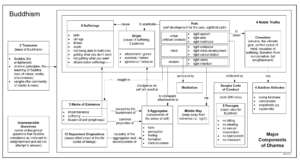Buddhism-in-a-Nutshell
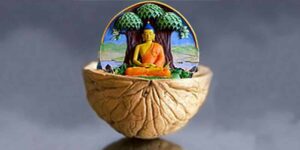
A Course In Buddhism Essentials
A downloadable .pdf format document of this page’s content can be found here.
Session 1
- Welcome everyone [15 minutes] Jim
- Introduce Facilitators
- Why we are here – plan on 4 more sessions
- Overview of the course – The starting point of Buddhism is reasoning or understanding or in Pali words Samma-ditthi.
2, What is suffering (Dukkha in Pali)? [30 minutes] Tom
- The meaning of Dukkha
- The 8 types of suffering
3.What is the cause of Suffering? [30 minutes] Jim
- In the Khandasutta, the Buddha tells us “And what, monks, the noble truth of the origin of suffering? It is this craving, causing renewed existence, accompanied by delight and lust, delighting here and there – that is, craving for sensual pleasures , craving for existence, craving for non-existence. This is called the noble truth of the origin of suffering”
- The 3 poisons – attachment to greed, attachment to hatred & ignorance (not understanding the Four Noble Truths).
4.Closing Both [15 minutes] Tom & Jim
- Questions?
- Our next scheduled session –
Chart of Major Course Components:
The Four Foundations

Session 2
- Welcome everyone [15 minutes] Jim
- Introduce Facilitators
- Why we are here – plan on 10 more sessions
- Overview of the course – The starting point of Buddhism is reasoning or understanding or in Pali words Samma-ditthi.
2, What is suffering (Dukkha in Pali)? [30 minutes] Tom
- The meaning of Dukkha
- The 8 types of suffering
3.What is the cause of Suffering? [30 minutes] Jim
- In the Khandasutta, the Buddha tells us “And what, monks, the noble truth of the origin of suffering? It is this craving, causing renewed existence, accompanied by delight and lust, delighting here and there – that is, craving for sensual pleasures , craving for existence, craving for non-existence. This is called the noble truth of the origin of suffering”
- The 3 poisons – attachment to greed, attachment to hatred & ignorance (not understanding the Four Noble Truths).
4.Closing Both [15 minutes] Tom & Jim
- Questions?
- Our next scheduled session
Buddhism-in-a-Nutshell
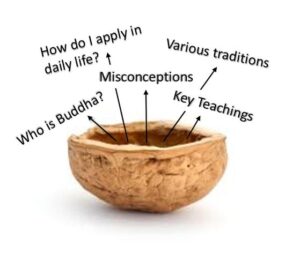
Session 3
- Welcome everyone [10 minutes] Jim
- Introduce Facilitators
- Why we are here – Brief summary of past sessions
- Overview of the course – The starting point of Buddhism is reasoning or understanding or in Pali words Samma-ditthi
2, What is the Fourth Noble Truth, the Noble 8-Fold Path [20 minutes] Tom
- The importance of Path
- How to use the 8 Factors of the Path (i.e. grouping, non-linier, ref Dependent Origination …)
3.The first Factor “Right View” [15 minutes] Jim
- The second Factor “Intention” [15 minutes] Jim
- The third Factor “Speech” [15 minutes] Tom
6.Closing Both [15 minutes] Tom & Jim
- Questions?
- Our next scheduled session –
| Essences of Right View
|
| Right View (Samma Ditthi) is the first element of the Noble Eightfold Path and lays the foundation for all other elements. Here are its essential points: |
| 1. Understanding the Four Noble Truths: Recognizing the reality of suffering (dukkha), its origin (samudaya), its cessation (nirodha), and the path leading to its cessation (magga). |
| 2. Law of Karma: Understanding that actions have consequences. Good actions lead to positive outcomes, while negative actions lead to suffering. This understanding guides ethical behavior and decision-making. |
| 3. Impermanence (Anicca): Acknowledging that all conditioned phenomena are transient and subject to change. This realization helps reduce attachment and promotes acceptance of change. |
| 4. Non-Self (Anatta): Understanding that there is no permanent, unchanging self. This insight helps reduce ego and self-centeredness, leading to greater compassion and wisdom. |
| 5. Interdependence (Paticca sam uppada): Recognizing the interconnectedness of all things and how various conditions give rise to experiences. This understanding fosters a sense of responsibility and mindfulness in our actions. |
|
Right Understanding provides the wisdom needed to guide one’s thoughts, actions, and speech in accordance with the principles of the Eightfold Path. It serves as the compass for the journey toward enlightenment and liberation from suffering.
|
Buddhism-in-a-Nutshell
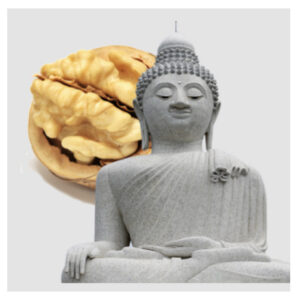
Session 4
- Welcome everyone [15 minutes] Jim
- A 5 minute Meditation
- Introduce Facilitators
- Why we are here
- Overview of the course – The starting point of Buddhism is reasoning or understanding or in Pali words Samma-ditthi.
- A quick Review of previous sessions
2.The fourth Factor “Right Action” [15 minutes] Tom
- The fifth Factor “Livelihood” [15 minutes] Tom
- The sixth Factor “Mindfulness” [15 minutes] Jim
6.Closing [15 minutes] Tom & Jim
- Questions?
- Our next scheduled session –
Buddhism-in-a-Nutshell

Session 5
- Welcome everyone [20 minutes] Jim
- A 5 minute Meditation
- Introduce Facilitators
- Overview of the course – The starting point of Buddhism is reasoning or understanding or in Pali words Samma-ditthi.
- A quick Review of previous sessions [Chart]
2.The seventh Factor “Effort” [20 minutes] Tom
- The eighth Factor “Concentration” [20 minutes] Jim
6.Closing [15 minutes] Tom & Jim
- Questions?
- Our next scheduled session –
Appendix
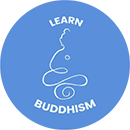
A downloadable .pdf format document of this page’s content can be found here.
Four Noble Truths:
Noble Eightfold Path:[Text Wrapping Break]
|

Three Characteristics or Marks of (Samsara) Existence:
- Transiency (anicca)
- Sorrow (dukkha)
- Selflessness (anatta)
Hindrances:
- Sensuous lust
- Aversion and ill will
- Sloth and torpor
- Restlessness and worry
- Sceptical doubt
Factors of Enlightenment:
- Mindfulness
- Investigation
- Energy
- Rapture
- Tranquillity
- Concentration
- Equanimity
The Five Aggregates
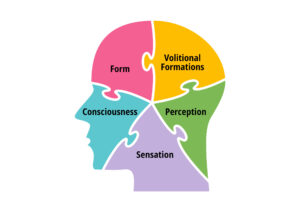
|
|||||||||||||||||
|
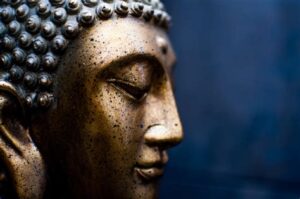
The boundless states or brahmaviharas are considered friends on the way to Nirvana. They help in dissolving the idea of a separate self. [Text Wrapping Break]
- Loving kindness
- Compassion
- Sympathetic Joy
- Equanimity
Near enemy is a quality that can masquerade as the original but is not the original. Far enemy is the clearly opposite quality. The boundless state serves as an antidote for the quality mentioned as the far enemy.
| The Brahma Viharas | ||||
| Pali | English | Description | Near Enemy | Far Enemy |
| metta | loving kindness | good-will, friendship, unconditional love for all beings | selfish love | hatred |
| karuna | compassion | empathy, to feel with someone instead of for someone | pity | cruelty |
| mudita | sympathetic joy | spontaneous joy in response to others success | hypocrisy | envy |
| upekkha | equanimity | even-mindedness based on insight into the nature of things | indifference | anxiety |

The Ten Perfections (Paramis) are:
- Morality (sila)
- Renunciation (nekkhamma)
- Wisdom (panna)
- Energy (viriya)
- Patience (khanti)
- Truthfulness (sacca)
- Resolution (adhitthana)
- Loving-Kindness (metta)
- Equanimity (upekkha)
THE JHANAS

Jhana (Pali) or dhyana (Sanskrit) is a term in Buddhism that refers to states of deep concentration and meditative absorption. Jhana is a core aspect of Buddhist meditation practice in the Theravada and early Buddhist traditions.
Jhanas are a sequence of progressively deeper states of concentration, each characterized by specific qualities and experiences. These states are achieved through sustained and focused meditation on a chosen object, such as the breath, a mantra, or a visualized image. The practitioner gradually moves through these stages, refining their concentration and insight.
The specific number and characteristics of jhanas can vary across different Buddhist traditions, but a common description often includes four main jhanas, plus four formless jhanas, resulting in a total of eight.
The First Jhana
his stage is marked by initial detachment from sensory distractions and the arising of a joyful, blissful state. The mind becomes unified and one-pointed on the chosen object of meditation.
The Second Jhana
In this stage, the initial joy transforms into a more refined, serene contentment. The meditator experiences a deep sense of tranquility and inner peace.
The Third Jhana
The experience of happiness further refines into equanimity. The practitioner becomes less attached to both pleasure and pain, entering a state of balanced mindfulness.
The Fourth Jhana
Equanimity becomes even more profound, resulting in a state of pure equanimity and mindfulness. The practitioner experiences a deep sense of mental clarity, balance, and focused awareness.
![]()

